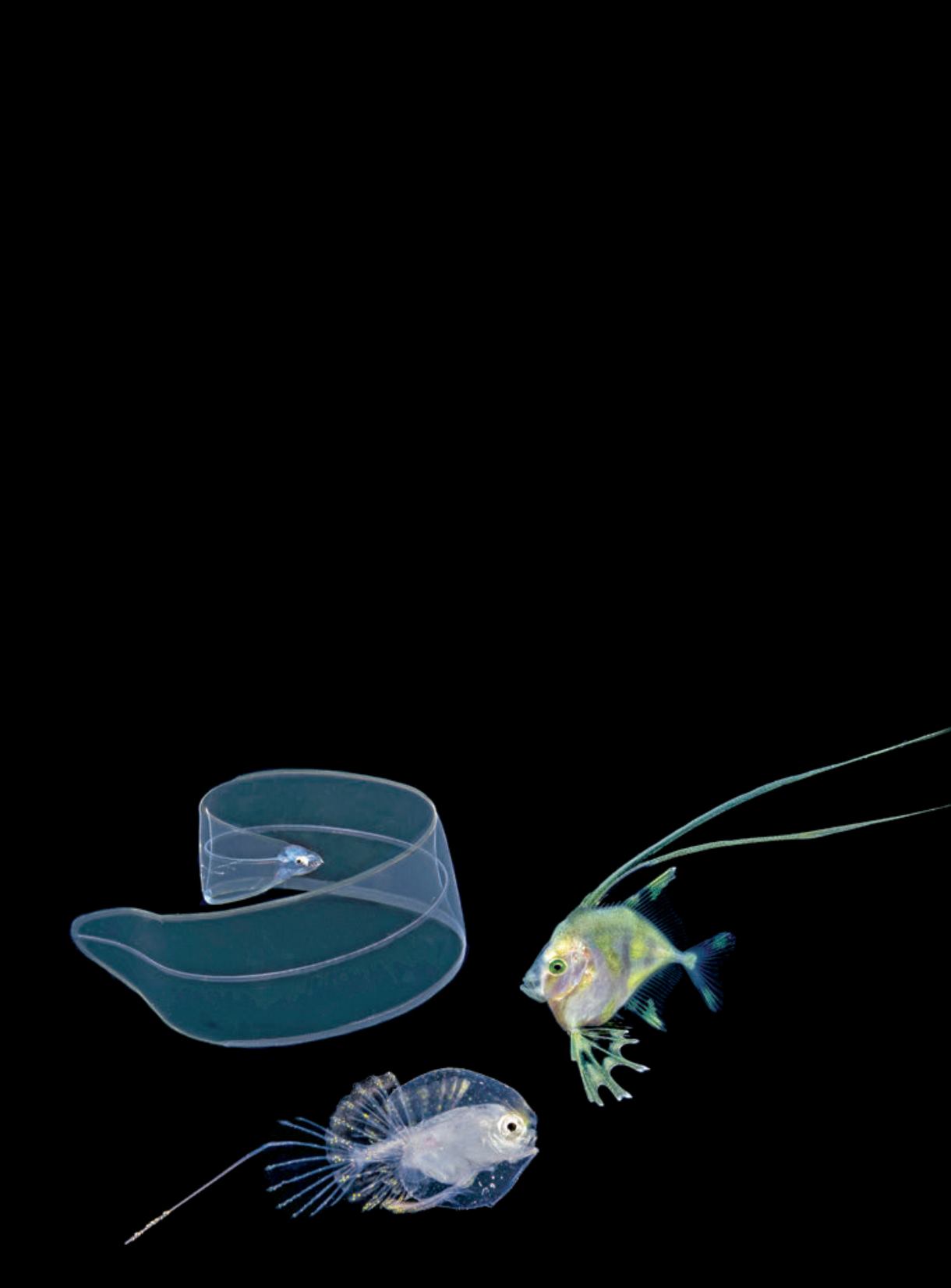

slackers; larval fish are small, fast, erratic and tricky to
track down in a featureless ocean. But when you find a
jaw-dropping and possibly never-before-photographed
animal, the thrill is as exhilarating as hooking a giant
sailfish — although the “sailfish” we find in our watery
fairyland can fit in the palm of your hand.
In less than 10 minutes Anna is spotlighting a larval
flounder that was drawn to her handlight like a moth
to a flame. Not knowing its behavior, I hold back and
watch one of the fanciest fish I’ve ever seen flutter in her
beam before flopping onto its side like a dead leaf. As I
inch closer, the fish rights itself and sails away. I’m close
behind, attempting to work my way alongside, focusing,
framing and hoping it will slow or turn back on itself.
Unsure how far I’ve traveled, I glance around, locate the
down line and turn back. The fish is gone.
I spiral, sweeping my light in a circle. Somehow
the beam catches a flicker of fins heading toward the
surface. I’m after it and only catch up when the fish
comes to a halt indignantly facing in the opposite
direction. I slip to its left, but the fish slips right. I pivot
right, it tacks left, flashing its tail in my face as it speeds
away. In fits and starts the chase continues until the
larva slows, makes an about face and swims toward me
at a leisurely pace. “Steady, steady,” I coach myself as the
flounder passes within a hand’s width, fins flying.
All it took was that one outrageous larval fish, and
Anna and I are hooked just like our South Florida
colleagues, who seldom, if ever, miss a scheduled night
drift. The majority are veteran Blue Heron Bridge
shooters — naturalists to the core and well-versed in the
trials and rewards of wildlife photography. As a group
they have taken to night drifts like ducks to water, but
they were not the first to fall under the spell of offshore
larvae. By the time the Florida folks made their first drift
two years ago, divers in Hawaii had been photographing
larval fish at night for 20 years. Inspired by legendary
underwater photographer Chris Newbert, their night
drifts, known in the islands as blackwater diving,
introduced larval art to the world. Our Florida friends
are happily carrying on the tradition 5,000 miles away.
Back on board, the boat is buzzing. Images of
unfamiliar animals attract the biggest crowds around
glowing camera screens. As you might expect, “What
is it?” is the most frequently asked question in a world
where crabs don’t look like crabs, and fish appear as
illusions. Photos of unidentified animals are forwarded
to two gentlemen half a world away who acquired their
taxonomic expertise cataloguing morphological sketches
of specimens swept up in plankton tows.
Scientific understanding of the oceanic orphanage
has been transformed in the past 15 years. It is no
longer thought to be an exclusively open system,
randomly transporting passive larvae to distant shores.
Recent studies have shown larval fishes to be strong
swimmers with sophisticated instincts for remaining
in local waters. But exactly where they go between
spawning and settlement remains a mystery. Meanwhile,
underwater photographers from Florida, Hawaii and
beyond are adding bits of understanding to the sea of
knowledge whose currents sweep us all along like night
drifters, having the time of our lives.
AD
ALERTDIVER.COM|
35
CLOCKWISE FROM LEFT: STEVEN KOVACS, SUSAN MEARS, DEBORAH DEVERS


















